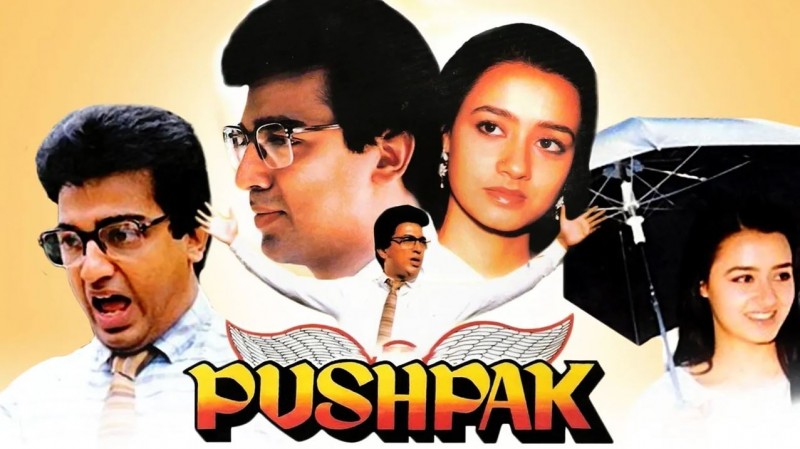
For his significant contributions to the craft of filmmaking, Satyajit Ray, a legendary Indian director and master of the silver screen, is revered. He made a lasting impression on Indian cinema with his meticulous attention to detail and mastery of narrative. Ray made a statement that would go down in film history after seeing Singeetam Srinivasa Rao's 1987 movie "Pushpak Vimana": "Singeetam Srinivasa Rao has created a love scene around a dead body." In addition to demonstrating Ray's admiration for the movie, this remark also highlighted Rao's brilliance and Kamal Haasan's spellbinding performance. The significance of Ray's remark, the movie "Pushpak Vimana," and the extraordinary talent of Singeetam Srinivasa Rao and Kamal Haasan will all be covered in this article.
Satyajit Ray, whose name is practically synonymous with Indian cinema, was an unmatched auteur. His realistic and insightful films brought him widespread acclaim and numerous honours, including the prestigious Academy Award for Lifetime Achievement in 1992. In addition to being a talented filmmaker, Ray was also a prolific author, illustrator, and composer. He has made immeasurable contributions to the fields of art and culture.
Ray's comment on "Pushpak Vimana" is an example of how he can recognise and value cinematic innovation. It is evidence of his adaptability and willingness to accept unusual narratives and storytelling techniques. Ray showed his profound knowledge of the changing landscape of cinema by praising the movie's original approach.
"Pushpak Vimana," a silent black-and-white movie that was released in 1987, defies accepted rules of narrative structure. The film, which was directed by Singeetam Srinivasa Rao, is a dark and eccentric comedy-drama that relies entirely on visual storytelling and the exceptional acting of its cast.
Kamal Haasan portrays the unnamed, young man who is without a job brilliantly in the movie. Haasan's persona serves as a metaphor for the loneliness and alienation that characterise urban life. He is a mute protagonist who encounters strange circumstances, such as a chance meeting with a stunning but impoverished woman (Amala Akkineni), with whom he falls in love. The protagonist's scheme to rob a wealthy man is the basis for the movie's main plot, which involves a number of darkly humorous incidents.
Satyajit Ray's statement, "Singeetam Srinivasa Rao has created a love scene around a dead body," was a profound critique of the film's story and visual style. In this context, the term "dead body" metaphorically refers to the urban environment and the alienation that permeates contemporary society. Within this dark and desolate setting, Rao cleverly created a love story that highlighted the absurdity of the characters' lives.
The film's brilliance lies in its capacity to make social commentary, humour, and emotional points without using words. Every shot, facial expression, and gesture become crucial components of the narrative. The "love scene" Ray alludes to is evidence of Rao's skill as a director in capturing the essence of interpersonal connection in the face of difficulty.
One of India's best actors, Kamal Haasan, gave an outstanding performance in "Pushpak Vimana." Haasan used only his facial expressions, body language, and gestures to portray a character who had no lines of dialogue. His portrayal of the nameless protagonist is a masterwork in silent acting, immersing viewers in the world of the character and simultaneously eliciting empathy and laughter.
In scenes with his love interest, played by Amala Akkineni, Haasan's ability to emote through his eyes and physicality is particularly striking. The audience is drawn to their unconventional love story by their endearing and humorous chemistry, which is conveyed without the use of words.
The creative director of "Pushpak Vimana," Singeetam Srinivasa Rao, deserves a lot of praise for coming up with the idea and carrying out a movie that defied expectations in Indian cinema. It was audacious of Rao to make a silent movie during a time when soundtracks and dialogue were the norm. But it was this audacity that gave him the chance to investigate the impact of nonverbal and visual storytelling.
The "Pushpak Vimana" film was brilliantly directed by Rao. He expertly conveys the emotions of the characters and the absurdity of the story using camera angles, lighting, and composition. His singular cinematic vision is demonstrated by his ability to combine dark humour with social commentary. The movie's success, both critically and financially, is evidence of Rao's skill as a storyteller.
"Pushpak Vimana" has a profound social commentary hidden beneath the humour and romance. Inequalities in urban life are highlighted by the film's depiction of the stark contrast between the wealthy and the poor. It illuminates the struggles and aspirations of the socially marginalised through the lens of its nameless protagonist.
Ray's remark about "Pushpak Vimana" also alluded to the movie's deeper levels. The film becomes a satirical critique of modernity and the detachment it brings by centering the love story around a lifeless urban landscape. This criticism has more impact because Rao chose silence as his medium of delivery.
As Satyajit Ray noted, "Singeetam Srinivasa Rao has created a love scene around a dead body," it is a moving tribute to the genius of "Pushpak Vimana." It captures the creative storytelling in the movie, Kamal Haasan and Amala Akkineni's outstanding performances, and Singeetam Srinivasa Rao's bold directing. "Pushpak Vimana" is still regarded as a cinematic masterpiece that never fails to move both filmmakers and moviegoers, serving as proof of the enduring value of silent storytelling in the movie industry.
Katrina Kaif Radiates as Uniqlo's Beacon in India's Fashion Galaxy
How Sri Lanka Became the Canvas for 'Bombay Velvet'
Mausam (2011), A Cinematic Odyssey Through the Changing Seasons of Emotion